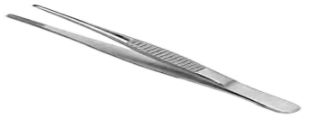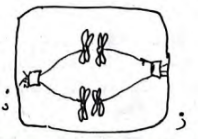INSTRUCTIONS TO CANDIDATES
- Answer all the questions.
- Answers must be written in the spaces provided in the question paper.
- Candidates may be penalized for recording irrelevant information and for incorrect spellings.
- The following apparatus is used in Biological studies.
- Identify the apparatus. (1mk)
- State its function. (1mk)
- Explain why protozoa do not require an elaborate gaseous exchange system. (2mks)
- Name two organisms that belong to the Kingdom Protista. (2mks)
- 60 black and 60 white mice were released in an area inhabited by jackals. After six weeks, it was established that 24 black and 8 white mice had remained.
- Account for the above observation. (3mks)
- Name the evolution theory that supports this observation. (1mk)
- A freshly obtained dandelion stem measuring 5cm long was split lengthwise to obtain two similar pieces. The pieces were placed in solutions of different concentration in petri dishes (L1 and L2) for 20 mins. The appearance after 20 mins is as shown.
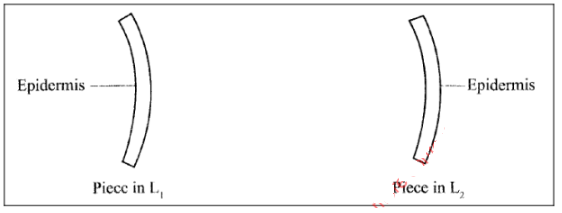
- Account for the appearance of the piece in solution L2 after 20 minutes. (3mks)
- State one significance of the biological process involved in the experiment. (1mk)
- State two environmental conditions that can lead to formation of carboxyhaemoglobin in the human body. (2mks)
- Name the part of the ovule that forms each of the following structures after fertilization:
- Zygote…………………………………………………………………………… (1mk) ii)
- Testa……………………………………………………………………………… (1mk)
- State two structural difference between motor and sensory neurons. (2mks)
Motor Neuron Sensory Neuron - Below is a diagram of an organism.
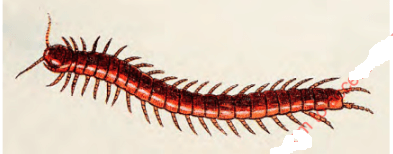
- Identify the Class to which the organism belongs. (1mk)
- State two features shown on the diagram that are characteristics of this Class. (2mk)
-
- Diffentiate between population and community as used in ecology. (1mk)
- Explain one negative effect of the use of herbicide on human health. (1mk)
- State two ways through which energy is lost from one trophic level to the next in a food chain. (2mks)
-
- Give two reasons why anaerobic respiration yields less energy than aerobic respiration. (2mks)
- Explain why fats are not efficient respiratory substrates. (2mks)
- The diagram below represents a stage in cell division.
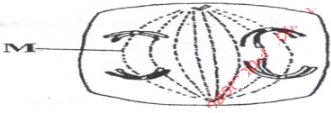
-
- Name the stage of cell division illustrated. (1mk)
- Give a reason for your answer in 14(a)(i). (1mk)
- In the space provided below, illustrate the next stage of cell division before the one shown above. (1mk)
- Give one disadvantages of inbreeding among living organisms. (1mk)
-
- The table below shows the concentration in parts per million of sodium and iodide ions in sea water and cell sap of a plant.
Sodium ions concentration Iodide ions concentration Sea water 326 39 Cell sap 162 574 -
- Which of the two ions intake will be affected if the plant was sprayed with a chemical that inhibits respiration. (1mk)
- Explain your answer in 10(a)(i) above. (1mk)
- An experiment was set up as shown in the diagram below.
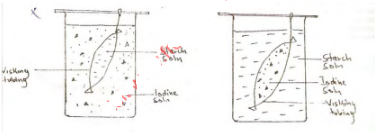
At the end of the experiment, it was observed that the starch turned blue black while the color of iodine solution in the beaker did not change. Account for this observation. (2mks)
-
- State the role of the following organelles: (3mks)
- Ribosomes
- Chloroplast
- Nucleus
- A goat and a sheep are both herbivores. Explain why the two can comfortably exist in the same ecosystem. (2mks)
- Explain the role of antidiuretic hormone when the human blood water level is below normal. (3mks)
- Equal amounts of crushed irish potato were placed in equal volumes of hydrogen peroxide solution at various pH values. A gas L was produced, its volume measured and recorded as shown below.
pH 4.2 7.0 9.2 Volume of gas L 2.9 5.9 7.9 - Identify gas L. (1mk)
- Account for the difference in the volume of gas L produced at pH values 4.2 and 9.2. (3mks)
-
- State two ways in which red blood cells are adapted to their function. (2mks)
- In which two forms is carbon (iv) oxide transported in the body. (2mks)
- State three characteridstics of a respiratory surface. (3mks)
- A student set up an experiment as shown in the diagrams below

The set up was at room temperature for a week- What was the aim of the experiment? (1mks) ………………………………………………
- What would be the expected results at the end of the experiment (2mks)
- After four months of pregnancy, the ovaries of a woman can be removed without terminating pregnancy. However, during the first four months of pregnancy, the ovaries must remain intact if pregnancy is to be maintained. Explain these observations. (2mks)
- The diagram below represents a transverse section of a young stem
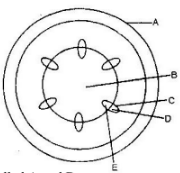
- Name the parts labelled A and B (2mks
- State two ways in which xylem vessels are adapted to their function. (2mks)
- A process that occurs in plants is represented by the equation below.
C6H12O6 → 2C2H5OH + 2CO2 + Energy
(Glucose) (Ethanol) (Carbon dioxide)- Name the process. (1mk) ………………………………………………………………………………………………………
- State two economic importance of the process named in (a) above. (2mks)
- Explain why some desert animals excrete uric acid rather than ammonia. (2mks)
- A shoot of seedling exposed to light on one side bends towards the source of light as it grows.
- Name the response exhibited by the shoot of the seedling. (1mk)
- Explain how the bending towards the source of light occurs. (3mks)
MARKING SCHEME
-
- pair of forceps
- picking/holding injurious/ stinging specimen
- They have a large surface area to volume ratio; diffusion (across the cell membrane) is sufficient for their gaseous exchange needs;
-
- Amoeba
- Paramecium
- Plasmodium
- Spyrogyra
- Euglena
- CHlamydomonas (First two)
-
- There was a greater decline in the number of white mice than black; white mice were selected against; they did not camouflage well with the surrounding; hence easily predated upon.
- Natural selection;
-
- L2 was hypertonic to the cell sap of the cortical cells; the cortex cells lost water by osmosis; causing the piece to bend/curve with epidermis; on the outer side ( epidermis is waterproof)
-
- Support in herbaceous plants; Reabsorption of water at kidney
- Absorption of water from the soil;
- Feeding in insectivorous plants; (Any other relevant answer)
-
- Burning carbon in inadequate supply of air e.g jiko
- Burning of fossil fuels/ emissions of carbon form exhaust fumes/ mines/ generators
-
- Egg cells;
- Outer Integument
-
Motor Neuron Sensory Neuron Cell body situated at one end of the axon Cell body situated off the axon Multiplar Bipolar -
- Chilopoda
-
- Body segmented (9-20) segments);
- A pair of legs per segment;
- Presence of poison claws Rj. " poisonous"
- Pair of antennae (First two)
-
- Population refers to organisms of the same species in a particular habitat at a particular time while community are different species living together in a particualr habitat.
- Herbicides (gradually) accumulate in foood chain (plant and animal tissues) which when fed on by human beings accumulate to toxic levels leading to death.
-
- Defaction Alt sp. defaecation
- Rsspiration
- Excretion i.e sweating, urination;
- Parts that are not consumed; (First two)
-
-
- Incomplete breakdown of the food substances;
- Absence of oxygen;
-
- Fats are insoluble in water hence not easily transported to respiring tissues;
- Fats required more oxygen to be oxidised; (completely)
-
-
-
- Anaphase I;
- Homologous chromosomes separate and migrate to opposite poles;
-
NB; Chromosomes at the equal of spindle still as bivalent -
- Hampers variation; resulting in transimission of undesired genes
- Loss of hybrid vigour/ No hybrid vigour; rej. low hybrid vigour
-
-
-
- Iodide ions; rej iodine ions
- The uptake of iodide ions is done by active transport; which is energy dependent, which when inhibited impairs active transport;
- Visking tubing being semi-permeable; alllowed selective passage of the small iodine moleculeinto it; starch molecules are bigger than the iodine hence could not diffuse the smaller pairs of the visking tuding into the beaker;
-
-
- Protein synthesis;
- Site for photosynthesis;
- Controls the activities of the cell;
- A goat is a browser while a sheep is a grazer; as a result; they can exist comfortably without competititon;
- (Body is dehydrated) more ADH is secreted; the ADH stimulates the kidney tubules to be more permeable to water; water is reabsorbed into the blood stream; the osmotic balance is attained;
-
- oxygen/O2 ;
- More gas was produces at pH 9.2 than pH 4.2; pH 9.2 was alkaline / basic; was favourable for the optimal work of enzyme (catalase) in the irish potato, lower pH 4.2 does not.
-
-
- Biconcave; increase SA for packaging of haemoglobin;
- Lack nuclues to create more room for packaging of haemoglobin
- Flexible to squeeze through the narrow capillaries;
- Presence of haemoglobin that has high affinity for oxygen;
-
- Solution form/ weak carbonic acid
- Carbaminohaemoglobin;
-
-
- Moist to dissolve respiratory gases;
- Large SA for maximum diffusion/ gaseous exchange;
- Thin walled/ epithelium for faster diffusion of gases.
- Must be permeable to respiratory gases;
-
- Investigate whether oxygen is necessary for germination;
-
- A - No germination;
- B - Germination occurred;
- Before 4 months of pregnancy, ovaries produce progesterone; after 4 months, placenta is fully developed and takes over the role;
-
-
- A - Epidermis;
- B - Pith;
-
- Lignified walls to prevent falling under pressure;
- Narrow lumen facilitate capillarity;
- Made of dead cells to allow passage of water;
- Pitted sideways for lateral movemnt of water;
- Long and continuously hollow for efficient movement of water;
-
-
- Anaerobic respiration; rej. respiration alone.
-
- Used in baking industries.
- Dairy industry to manufacture dairy products e.g yoghurt
- Brewing industries to make alcohol
- Manufacture of organic acids;
- Treatment of sewage
(More othe rrelevant answers)
- Ammonia is less soluble in water; hence requires more water to be eliminated / excreted;
-
- Positive phototropism;
- Auxins being sensitive to light, migrate laterally to the darker side; higher concentration of auxins on the darker side stimulates faster growth; the shoot bends towards direction of light.
Join our whatsapp group for latest updates
Tap Here to Download for 50/-
Get on WhatsApp for 50/-
Download Biology Paper 1 Questions and Answers - Maranda High Pre Mock Exams 2023.
Tap Here to Download for 50/-
Get on WhatsApp for 50/-
Why download?
- ✔ To read offline at any time.
- ✔ To Print at your convenience
- ✔ Share Easily with Friends / Students

